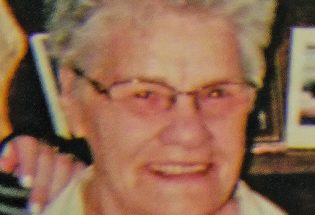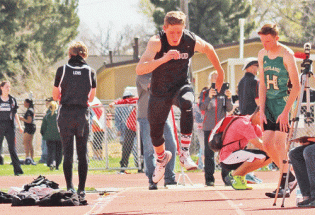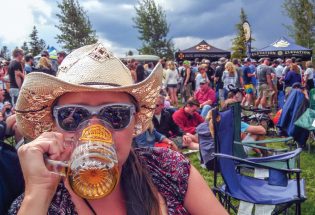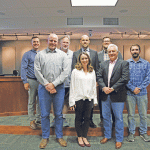Berthoud’s Roots mural a work of public art reflecting our past
By Terry Georgia
The Surveyor
One of the most distinctive and recognizable landmarks in Berthoud is the enormous, brightly colored mural adorning the south side of the historic grain elevator on Third Street downtown. Called “Berthoud’s Roots,” the mural was designed to reflect the agricultural foundation of Berthoud’s history and community values.
Northern Colorado artist Susan Dailey, an experienced muralist, started designing the piece in 2004, working closely with the Berthoud Arts & Humanities Alliance (BAHA) to approve the design and secure the permissions necessary to use the grain elevator as her canvas. It took almost a year to design the mural, another four months to paint it, and about three weeks to install it. In all, the artists spent more than 2,000 hours over five months completing the project once it was approved. Each step was an enormous challenge.
Dailey had painted many murals, but none on such a large scale. She enlisted the help of artist Eleanor Yates to help move the project from concept to completion. Dailey and Yates first met when Yates was just ten years old and Dailey was a substitute art teacher in her school. “Then when I was 12, I saw Susan painting the mural at Avogadro’s Number [in Ft. Collins] and I was hooked. I thought it was so cool,” Yates remembered of their earliest encounters, “but it wasn’t until I was in college that we really met and started doing some small projects together.” Yates eventually went to Philadelphia, where she studied with Meg Saligman, a muralist who has done some of the largest public murals in the world. Saligman’s innovative technique would make Berthoud’s mural possible.
The mural is not actually painted directly on the building. Instead, Dailey and Yates painted 55 acrylic panels in Dailey’s studio. Each panel measures five feet by five feet. Once the painting was finished, the panels were secured to the grain elevator using Saligman’s technique which Dailey describes as “kind of like decoupage.”
All 55 panels had to be aligned perfectly, which Dailey said was daunting. “I’m used to working on murals I can step back from,” said Dailey, describing the challenge of not being able to see anything but small parts of the design while they were working, “we didn’t know what this one was really going to look like until it was up. That was scary!”
Yates agreed. They not only had to wrangle the huge panels in the studio, they had to use a huge industrial lift as their working platform when it came time to install the panels on the grain elevator. “I had to learn to drive and maneuver a lift for this project,” said Yates with a laugh, “being an artist means learning all kinds of new skills!”
Dailey and Yates recruited other helpers including local artist Juli Schrader to assist with the installation. Yates remembers how much fun they had working on the mural together, “All three of us love to sing, so we’d be up on that lift singing three-part harmonies. It was so much fun.”
Both Dailey and Yates fondly recall their time working in Berthoud. “The whole thing was such a warm experience for us,” said Dailey, “local people stepped in to help. Everyone was great.” Yates remembers the kindness of Berthoud residents as well, “It was fun to be there,” she said, “people were so supportive and so kind. Small farming towns are not a thing of the past. I hope that feeling lives on in the mural.”
The people depicted in the mural are reminiscent of a multi-generational farming family. Several Berthoud residents served as models for the painting, but it does not portray a particular family, instead, it is meant to represent the family values that were there at the town’s founding and still prevail in Berthoud today.
The grain elevator on which the mural is fixed was first built in 1885 according to the Berthoud Historical Society. It later became part of a flour mill added in 1888. The mill was Berthoud’s only factory from the 1880s to the 1940s. The mill was demolished in 1966, but the grain elevator remained in use until 1980. Since 2013, the building has been home to The Rancher’s Wife, a store selling Colorado-made products, vintage items, antiques and collectibles.
The Berthoud’s Roots mural was completed and dedicated on November 12, 2005. It requires a fresh protective coating every seven years to ensure the colors stay bright and free from damage. Susan Dailey hopes to retouch the painting and apply that protective coating in the spring or summer of 2023.
Susan Dailey is still painting and plays in a bluegrass band called The McDaileys. Ella Yates is now a music therapist and touring performer.
The Berthoud Arts and Humanities Alliance continues to support public art projects around town, including several other murals and the sculpture garden at Fickel Park. Pick up a map showing all of Berthoud’s public art spaces at the Wildfire Arts Center, 425 Massachusetts Ave.
- September, 14 2018

Obituary – Kathlyn Ann Adler
Kathlyn Ann Adler March 11, 1929 - September 5, 2018 Kathlyn Ann Adler, 89, of...
- September, 14 2018

Obituary – George A. Christman
George A. Christman George A. Christman of Berthoud Color. passed away on Aug. 31, 2018...
- October, 18 2019

- April, 27 2017

Berthoud’s Brock Voth breaks 25-year-...
By Kristi Leonard The Surveyor Photo by Tiffany RaffertyBrock Voth broke...
- October, 05 2018

Obituary – Harlan John Schultz
Harlen John Schultz May 18, 1930 - September 24, 2018 Harlen...
- April, 30 2015

Celebrating Colorado, and girls named...
Local travel writer hosts her own festival in Ouray By John Gardner The Surveyor [caption...

Unified basketball comes to Turner Middle School
Community News

Mike Grace says goodbye as Brett Wing joins town board
Community News
POLICEBLOTTER
Community News
Northern Water sets C-BT quota at 70% for 2024
Community News

Emotions run high during Revere Property hearing
Community News
Snowpack at 119% above normal
Community News

Karspeck to serve third term as Berthoud mayor
Community News
COMMUNITY CALENDAR:
Community Calendar – add an event
Homestead Fine Art Gallery First Fridays OPEN HOUSE
03 May 4:00 PM - 7:00 PM
Homestead Fine Art Gallery First Fridays OPEN HOUSE
07 Jun 4:00 PM - 7:00 PM
Homestead Fine Art Gallery First Fridays OPEN HOUSE
05 Jul 4:00 PM - 7:00 PM
Homestead Fine Art Gallery First Fridays OPEN HOUSE
02 Aug 4:00 PM - 7:00 PM
Homestead Fine Art Gallery First Fridays OPEN HOUSE
06 Sep 4:00 PM - 7:00 PM
Homestead Fine Art Gallery First Fridays OPEN HOUSE
04 Oct 4:00 PM - 7:00 PM

